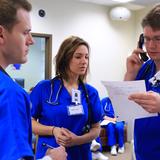School Highlights
West Georgia Technical College serves 8,936 students (24% of students are full-time).
The college's student-teacher ratio of 19:1 is higher than the state community college average of 18:1.
Minority enrollment is 51% of the student body (majority Black), which is less than the state average of 61%.
Quick Facts (2025-26)
- Enrollment: 8,936 students
- In-state tuition: $2,724
- Out-state tuition: $4,860
- Student-teacher ratio: 19:1
- Minority enrollment: 51%
- Source: Integrated Postsecondary Education Data System (IPEDS)
Top Rankings
West Georgia Technical College ranks among the top 20% of public schools in Georgia for:
Category
Attribute
Community Size
School Overview
The teacher population of 483 teachers has stayed relatively flat over five years.
West Georgia Technical College
(GA) Community College Avg.
Carnegie Classification
Associate's Colleges: High Career & Technical-Mixed Traditional/Nontraditional
Associates--Public Rural-serving Medium
Institution Level
At least 2 but less than 4 years
At least 2 but less than 4 years
Institution Control
Public
Public
Total Faculty
483 staff
209 staff
School Calendar
Student Body
The student population of West Georgia Technical College has grown by 26% over five years.
The student-teacher ratio of 19:1 has increased from 13:1 over five years.
The West Georgia Technical College diversity score of 0.62 is less than the state average of 0.71. The school's diversity has grown by 8% over five years.
Total Enrollment
8,936 students
2,604 students
Student-Teacher Ratio
19:1
18:1
# Full-Time Students
2,156 students
882 students
# Part-Time Students
6,780 students
1,722 students
# Enrollment Undergraduate
893 students
299 students
# Full-Time Undergraduate Students
2,156 students
929 students
# Full-Time Graduate Students
n/a
87 students
# Part-Time Undergraduate Students
6,780 students
1,848 students
# Part-Time Graduate Students
n/a
53 students
Total Dormitory Capacity
n/a
654 students
% American Indian/Alaskan
n/a
n/a
% Asian
1%
4%
% Hispanic
9%
10%
% Black
36%
35%
% White
49%
39%
% Hawaiian
n/a
1%
% Two or more races
4%
3%
% Non Resident races
n/a
1%
% Unknown races
1%
7%
Diversity Score
0.62
0.71
College Completion Rate (Students who graduate in less than 4 years)
34%
43%
College Completion Rate (Students who graduate in 4 years or more than 4 years)
n/a
24%
Average Graduate Earnings (10 Years)
$29,500
$29,500
Tuition and Acceptance Rate
The public in-state tuition of $2,724 is less than the state average of $3,403. The in-state tuition has declined by 10% over four years.
The public out-state tuition of $4,860 is less than the state average of $7,170. The out-state tuition has declined by 10% over four years.
In-State Tuition Fees
$2,724
$3,403
Out-State Tuition Fees
$4,860
$7,170
Tuition Notes
$107 per credit hour
% Students Receiving Some Financial Aid
94%
93%
Median Debt for Graduates
$11,222
$12,139
Median Debt for Dropouts
$4,874
$5,500
Acceptance Rate
n/a
75%
SAT Reading
n/a
465
SAT Math
n/a
450
SAT Writing
n/a
465
ACT Composite
n/a
18
ACT English
n/a
18
ACT Math
n/a
18
ACT Writing
n/a
7
Source: 2024 (or latest year available) Integrated Postsecondary Education Data System (IPEDS) , School Administrators
Frequently Asked Questions
How much does West Georgia Technical College cost?
West Georgia Technical College's tuition is approximately $2,724 for In-State students and $4,860 for Out-State students.
What is West Georgia Technical College's ranking?
West Georgia Technical College ranks among the top 20% of community college in Georgia for: Largest student body.
Recent Articles

Community College Success Rates 2025: Outcomes & Trends
Updated 2025 analysis of community college success rates, completion, transfer, costs, enrollment, and strategies that shape student outcomes.

Community Colleges in 2025: Combating Stereotypes with Impact
Updated insights on how community colleges are dispelling myths, growing enrollment, and expanding pathways in 2025.

2025 FAFSA Changes Explained for Community College Students
A comprehensive guide to 2025 FAFSA changes, what community college students must know, new eligibility rules, timelines, and tips to maximize federal aid.










